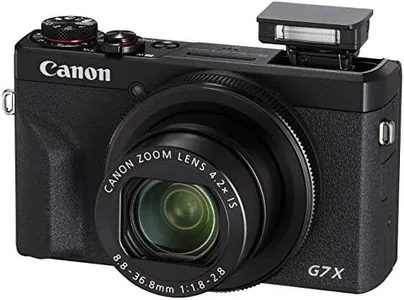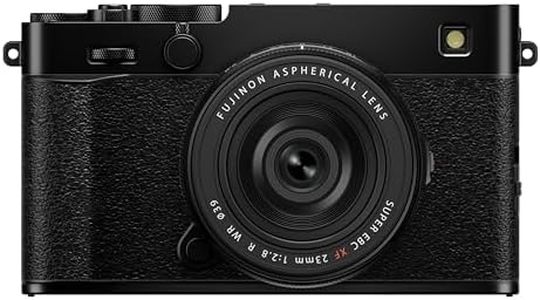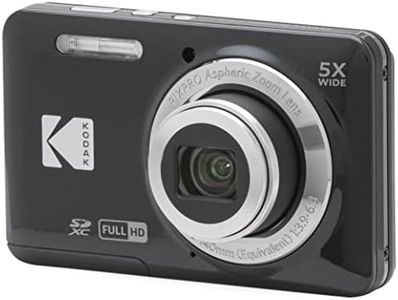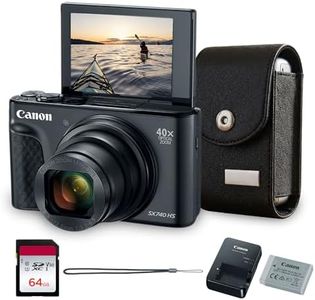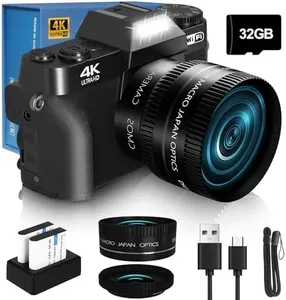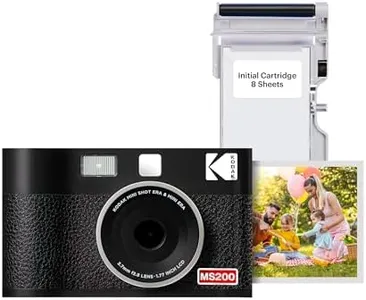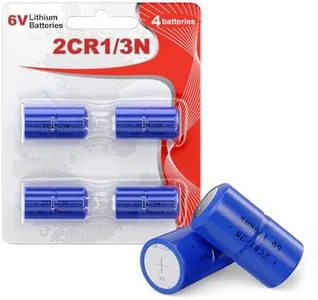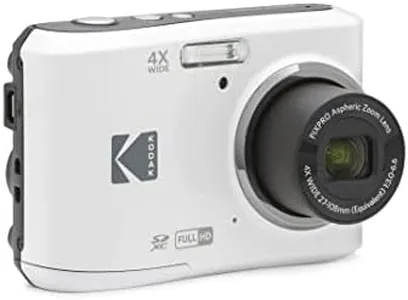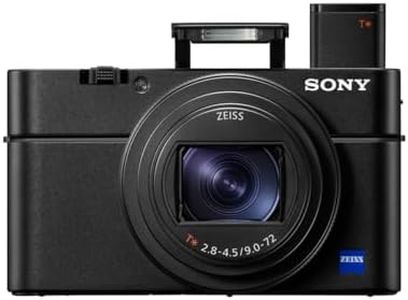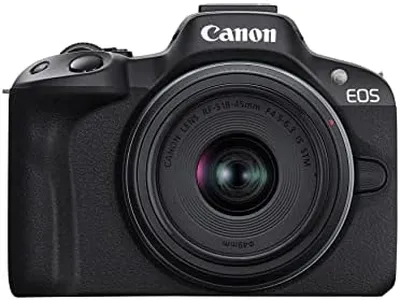10 Best Digital Cameras 2025 in the United States
Our technology thoroughly searches through the online shopping world, reviewing hundreds of sites. We then process and analyze this information, updating in real-time to bring you the latest top-rated products. This way, you always get the best and most current options available.

Our Top Picks
Winner
Canon PowerShot G7 X Mark III Digital Camera (Black)
Most important from
963 reviews
The Canon PowerShot G7X Mark III is a compact digital camera that packs a punch, making it an excellent choice for both photography and videography enthusiasts. With a 20.1 Megapixel stacked CMOS sensor and DIGIC 8 image processor, it delivers high-quality images with impressive detail. The 4.2x optical zoom lens (24-100mm f/1.8-2.8) offers versatility for capturing a range of subjects, from wide landscapes to close-up portraits, while the optical image stabilization helps keep your shots steady, reducing blur during handheld shooting.
For those interested in video, the G7X Mark III supports 4K video recording at 30 frames per second, along with full HD at 120 frames per second for capturing slow-motion footage. This feature is particularly appealing for content creators and vloggers. Additionally, it can easily be used as a high-quality webcam, which is a nice bonus for live streaming.
However, there are some limitations to consider. The autofocus system relies on contrast detection, which may not be as fast or reliable as phase-detection autofocus found in higher-end models, especially in low light conditions. The battery life, while decent, may not last through extended shooting sessions, and an extra battery might be necessary for long days out. Also, it has a single SD card slot, which could be a drawback for users requiring more storage flexibility.
In terms of connectivity, the G7X Mark III includes Wi-Fi and NFC, allowing for easy sharing of photos and videos directly to your devices. The camera's build quality feels solid, but its compact size may not appeal to everyone, especially those who prefer a more robust feel.
The Canon PowerShot G7X Mark III is ideal for travelers, vloggers, and casual photographers who want a portable and powerful camera. While it has a few drawbacks, its strengths in image quality, video capabilities, and user-friendly features make it a strong contender in the compact camera category.
Most important from
963 reviews
FUJIFILM X-E5 Mirrorless Digital Camera XF23mmF2.8 Lens Kit - Black
Most important from
49 reviews
The Fujifilm X-E5 is a stylish and compact mirrorless camera that offers excellent image quality thanks to its large 40.2-megapixel APS-H sensor, which is larger than many typical APS-C sensors. This means you get sharp, detailed photos ideal for enthusiasts who want high resolution without the bulk of a DSLR. It comes with a 23mm f/2.8 prime lens that’s great for everyday shooting and street photography, although being a prime lens means no optical zoom; you must switch lenses for different focal lengths or rely on the 1.4x or 2x digital zoom, which can reduce image quality. The camera’s autofocus system is advanced with 49 hybrid points and AI-powered subject detection, making focus quick and accurate for photos and 4K video at up to 30fps.
A big plus is the in-body image stabilization (IBIS), which helps reduce blur from shaky hands, especially in low light, offering up to seven stops of stabilization at the center. The physical controls mimic classic film cameras, making it intuitive for users who prefer tactile dials over touchscreen menus, and the customizable Film Simulation dial is a fun feature for creative shooting without post-processing. Weighing about 2 pounds, it balances portability with a solid feel.
On the downside, the camera lacks a built-in flash and audio recording in video mode, which might limit versatility for casual video users. Also, it’s not weather-sealed, so extra care is needed in harsh conditions. Battery life is moderate, around 5 hours per charge, which is typical but may require carrying a spare for long shoots. This camera suits photography enthusiasts who appreciate high-res images, manual controls, and lens flexibility in a stylish, compact body. Beginners might find some features complex, but those looking to grow their skills will enjoy its balance of classic design with modern tech.
Most important from
49 reviews
Canon Cameras US Point and Shoot Digital Camera with 3.0" LCD, Silver (2956C001)
Most important from
1580 reviews
The Canon PowerShot SX740 HS is a compact point-and-shoot camera designed for users who want a versatile camera without the complexity of interchangeable lenses. It features a 20.3-megapixel CMOS sensor, which is good for capturing detailed photos suitable for everyday photography and travel. The standout strength is its powerful 40x optical zoom with image stabilization, allowing you to take clear shots even from far away without much blur. This zoom range covers wide-angle to telephoto, making it flexible for landscapes and distant subjects.
Autofocus uses contrast detection with a single focus point, which is decent for most casual photography but might struggle a bit in low light or on fast-moving subjects. The camera shoots high-resolution 4K video and offers 4K time-lapse, which is great if you want to capture smooth and sharp videos beyond full HD quality. The 3-inch tilt-type LCD screen makes framing shots easier, especially for selfies or shooting at unusual angles. It lacks an optical viewfinder, so you’ll rely on the screen to compose images. Battery life is average for this class, powered by a rechargeable lithium-ion battery; expect moderate shooting time before needing a recharge.
Connectivity options include built-in Wi-Fi and Bluetooth, making it simple to transfer photos to your smartphone or control the camera remotely. Build quality is typical for a compact camera, lightweight and easy to carry, but it isn’t water-resistant, so extra care is needed outdoors. This camera suits casual photographers, travelers, or anyone wanting a simple, all-in-one camera with strong zoom and good video features. It may not meet the needs of advanced users looking for fast autofocus or professional controls, but it balances ease of use and capability well for its category.
Most important from
1580 reviews
Buying Guide for the Best Digital Cameras
Choosing the right digital camera can feel overwhelming because there are so many options and technical terms. The best approach is to think about what you’ll use the camera for most often—whether it’s capturing family moments, traveling, sports, landscapes, or creative photography. By understanding the most important features, you can focus on what matters most to you instead of just chasing the highest numbers.FAQ
Most Popular Categories Right Now


